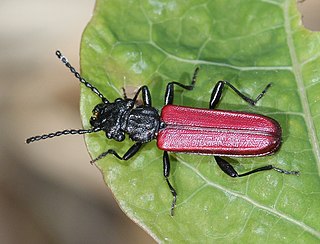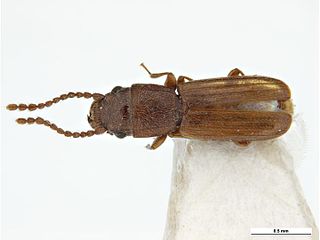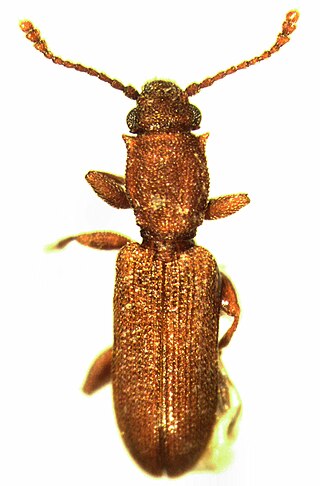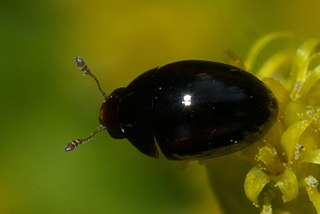
The Cucujidae, "flat bark beetles," are a family of distinctively flat beetles found worldwide under the bark of dead trees. The family has received considerable taxonomic attention in recent years and now consists of 70 species distributed in five genera. It was indicated Cucujus species are scavengers, only feeding on pupae and larvae of other insects and on other subcortical beetles such as their own. Since the Cucujidae prey on larvae of potentially tree damaging beetles that spread fungal diseases, they are considered to be beneficial to the health of living trees.

Cryptolestes is a genus of beetles in the family Laemophloeidae. Several species are known as economically important pests of stored products, especially food grains. The four most notorious species are Cryptolestes ferrugineus, Cryptolestes pusilloides, Cryptolestes pusillus, and Cryptolestes turcicus. C. capensis, C. klapperichi, and C. ugandae are less widespread pests. Species in this genus can be hard to distinguish from one another, and definitive identification often requires close examination of the genitalia.

Erotylidae, or the pleasing fungus beetles, is a family of beetles belonging to Cucujoidea containing over 100 genera. In the present circumscription, it contains 6 tribes and 10 subfamilies. In other words, the narrowly circumscribed Erotylidae correspond to the subfamily Erotylinae in the definition sensu lato. There are doubts on the monophyly of lower ranked taxa within Erotylidae, with further phylogenetic studies requiring better sampling and studies of unexplored character sets, for example the metendosternite and penile flagellum, which are generally lacking detailed morphological studies within the Coleoptera literature. The Eroytlina taxonomy is based on traits such as their different colors and not off morphological differences like mouthparts, thorax, and abdominal terminalia (Pecci-Maddalena).

Cucujus is a genus of beetles in the family Cucujidae, the flat bark beetles. It contains 19 currently recognized species and subspecies.

Laemophloeidae, "lined flat bark beetles," is a family in the superfamily Cucujoidea characterized by predominantly dorso-ventrally compressed bodies, head and pronotal discs bordered by ridges or grooves, and inverted male genitalia. Size range of adults is 1–5 mm (0.04–0.2 in) in length. Currently, it contains 40 genera and about 450 species, and is represented on all continents except Antarctica; species richness is greatest in the tropics.

Silvanidae, "silvan flat bark beetles", is a family of beetles in the superfamily Cucujoidea, consisting of 68 described genera and about 500 described species. The family is represented on all continents except Antarctica, and is most diverse at both the generic and species levels in the Old World tropics.

Blubos is a genus of beetles in the family Laemophloeidae. The only known species in the genus is Blubos matris, a large (4 mm) yellowish beetle with darkly fasciate elytra. It differs from all other known laemophloeids in that the lateral margins of the pronotum are visible in dorsal view. It is known from a single specimen collected more than 60 years ago in the Democratic Republic of the Congo. Nothing is known of its biology or immature stages.

Dysmerus is a genus of beetles in the family Laemophloeidae. Restricted to the New World, until recently Dysmerus included only the type species, D. basalis, described from Florida in the late 19th century. A recent revision resurrected two incorrectly synonymized species and recognized an additional 12 new species, so that the genus currently contains 15 species.

Laemophloeus is a genus of beetles; it is the type genus of the family Laemophloeidae. The genus has been almost completely reviewed in modern times.

Lathropus is a genus of beetles in the family Laemophloeidae. It has been the subject of recent taxonomic study. Lathropus species are minute (<2mm) flattened beetles with short, clubbed antennae, closed mesocoxal cavities, extremely dense surface sculpture, and dorsal pubescence composed of bifurcate setae. Currently recognized valid species are:
Leptophloeus is a genus of beetles in the family Laemophloeidae, containing the following species:

Metaxyphloeus is a genus of beetles in the family Laemophloeidae. It belongs to a small group of rostrate laemophloeid genera endemic to the New World. Members of Metaxyphloeus range from southern Texas south to Bolivia. Related rostrate genera are Rhinomalus and Rhinophloeus. Adults are moderate-sized laemophloeids (~2 mm) characterized by their prolonged heads, open procoxal cavities, an acuminate intercoxal process on the first visible abdominal ventrite, antennal club of six antennomeres, and male genitalia lacking a dorsal piece of the tegmen. Metaxyphloeus adults are dark brown or black, shining, with or without dorsal pubescence, and with one or two pairs of pale elytral maculae. Their biology and immature stages are unknown. Adults may be attracted to light in forest habitats. The function of the rostrum is unknown.
Microbrontes is a genus of beetles in the family Laemophloeidae, containing the following species:
Xylophloeus is a genus of beetles in the family Laemophloeidae, containing the following species:

Silvanus is a genus of beetles in the family Silvanidae, containing the following species:

Monotomidae is a family of beetles in the superfamily Cucujoidea. The family is found worldwide, with approximately 240 species in 33 genera. The ecological habits of the family are diverse, with different members of the group being found under tree bark, in decaying vegetation, on flowers and in ant nests. Their ecology is obscure, while at least some species are mycophagous, feeding on the fruiting bodies of ascomycete fungi, Rhyzophagus are predators on bark beetles and possibly Phoridae larvae, with the larvae of some species also being mycophagous.

Pediacus is the largest genus in the family Cucujidae of flat bark beetles. It contains 31 currently recognized species. Pediacus adults are relatively small (2.7-7.0mm), flattened brownish beetles with no or very small temples, and short antennae with a distinct club. Male genitalia are inverted and possess a short flagellum.

Euxestidae is a family of beetles in the superfamily Coccinelloidea, formerly included within the family Cerylonidae. They are around 70 extant species in 10 genera, distributed primarily in the tropical and subtropical regions of Afro-Eurasia. They are found in decomposing wood, leaf litter, ant nests, and the fungus gardens of termites. All species are presumed to be mycophagous.

Olibrus is a genus of shining flower beetles in the family Phalacridae. There are at least 30 described species in Olibrus.
Silvanoprus longicollis, is a species of silvan flat bark beetle found in India, Sri Lanka, Malaysia, Java, China, Japan, Madagascar and East Africa.














